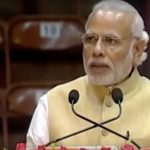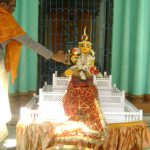Q. I understand that in Gaudiya Vaisnavism devotees sometimes desire to have a romantic relationship with Krsna. Please explain something about this.
A. In discussing Krsna's relationship with the gopis, Sri Rupa Goswami mentions two possible types, sambhogecchamayi and tad-bhavecchamayi. The former is the role of a gopi who has a direct love affair with Krsna and the latter is the role of assisting a gopi group leader who has a direct love affair with Krsna. Although both are mentioned, in Gaudiya Vaisnavism the latter is considered preferable. According to both Sri Jiva Goswami and Sri Visvanatha Cakravarti, it is the principal form of conjugal love in relation to Sri Krsna that devotees in our lineage aspire for.
Gopis in this mood love both Radha-Krsna, but with stronger attachment to Sri Radha. These handmaids of Sri Radha feel that assisting in her relationship with Krsna is even more desirable than uniting personally with him. Sri Rupa Goswami also terms this sentiment bhavollasa-rati. Over time devotees have also referred to it as Radha-dasyam, manjari-bhava, and so on. It is the unique emphasis of Sri Caitanya Mahaprabhu.
For more information read the following Sanga: Bhavollasa Rati: Love for Radha-Krsna Combined
Q. I read a contentious article in which the term manjari-bhava was referred to as the codeword for prakrta-sahajiyas (imitation devotees). Can you comment?
A. My writing previously received a similar critique by the same author. In answer to a Sanga question, I wrote a brief explanation of the term bhavollasa-rati. After my reply was published, the author of the article you refer to wrote a personal attack against me, at that time labeling bhavollasa-rati the "codeword for sahajiyas." Now, in a recent article he himself uses the term bhavollasa-rati, citing Rupa Goswami's Bhakti-rasamrta-sindhu.
In response I wrote that I first read this term in one of the books of Srila Sridhara Maharaja, referring to his Bengali translation of Bhakti-rasamrta-sindhu, published with Sri Jiva's commentary, wherein the term bhavollasa-rati is used and discussed. At the time he was adamant that the term could not be found anywhere in the publications of Srila Sridhara Maharaja.
As for the term manjari-bhava, it is found in Sripad Bon Maharaja's commentary on Bhakti-rasamrta-sindhu, a book approved by Srila Sridhara Maharaja. While it is true that Srila Sridhara Maharaja did not regularly use this term, he certainly discussed the subject as recorded in his published lectures. Indeed, information on the relationship between Radha-Govinda and the manjaris is found in practically all of his books, as it is not possible to enter into a comprehensive understanding of Gaudiya Vaisnavism without this knowledge.
For example, Srila Sridhara Maharaja informs us in Sri Guru and His Grace, "Even the sakhis in madhurya-rasa cannot enter where Radha-Govinda are united privately, but the manjaris are allowed there. They are the younger section, and that is the highest rasa. So the highest point of our attainment, of our aspiration is there, rupanuga–Rupa Manjari. She is the leader of all the manjaris and there the highest quality of union in rasa is found.
"So in that highest stage of the mixing of Radha-Govinda–free play of Radha-Govinda–these manjaris, the younger girls, they can have admission. But the grown-up sakhis they cannot have admission there. New recruits come to manjari class, up to manjari class. And the manjari has got that sort of special advantage under the leadership of Rupa Manjari. So they get the best advantage there, the most sacred type of pure service is open to the manjaris in Radharani's camp. So Rupanuga position, the most profitable position, has been given out by Mahaprabhu. That is the highest limit of your fortune. This has been shown. Beyond hope, our highest prospect lies there in that subtle camp of Sri Rupa, Rupa Manjari, Rupa Goswami. So the sampradaya of Mahaprabhu is known as Rupanuga sampradaya. There is located our fate, our fortune."
Q. In that article the idea was presented that spiritual union with Krsna is a lesser experience than that of love for him in separation. Would you be so kind as to comment on this?
A. Gaudiya acaryas have expressed nuanced differences of opinions on this subject, and sometimes an acarya will glorify union and at another time the same acarya will glorify separation. For example, my own siksa guru, Pujyapada B.R. Sridhara Deva Goswami said, "When Radha-Govinda are alone in union, the highest quality of rasa is to be found in their lila." However, he also said, "Dedication in its highest state is union in separation."
To speak conclusively on this subject, one must be well acquainted with the Goswami literature that deals specifically with it. It is a vast topic. The terms vipralambha and sambhoga refer to union and separation in conjugal love and in prema-bhakti there are four types of each of these. In the other rasas of Vraja, union and separation are termed yoga and ayoga, and because Radha's manjaris are her servant friends, yoga and ayoga are also pertinent to their bhava as dasis of Sri Radha. Three types of yoga and two types of ayoga are discussed in the Goswami granthas (scriptures).
For the most part, service in separation is emphasised because separation is the low tide of the ocean of prema, during which one can enter her waters. Sri Caitanya taught this by his example in the final years of his lila. He meditated on lilas overflowing with Radha's feelings of separation from Krsna, such as her song to the bumblebee (Bhramara-gita). Sadhakas should follow his example. In the first stages of prema, there is also a particular type of love in separation known as purva-raga (for those engaged in kamanuga) or utkantha (for those engaged in sambandhanuga), which prepares one for one's initial union with Krsna in his manifest lila in Vrndavana. In the Bhagavata we also find that the course that the kamanuga sadhana-siddhas passed through involved intense separation, which paved the way for their eventual union with Krsna. In the poetry of the Bhagavata, they died in separation before coming to live in love with Krsna.
While the importance of separation has been illustrated in brief above, it is clear that such separation begets union. The secular theory of rasa, which Rupa Goswami employed to explain the nature of bhakti-rasa, teaches that the purpose of love in separation is to foster love in union. Thakura Bhaktivinoda has cited this idea in his commentary on Siksastakam 7, which is about love in separation. Thus union should not be dismissed. Indeed, we seek the union of Radha-Krsna, and Rupa Goswami writes in his Ujjvala-nilamani that the highest expression of love of God, called madanakhya-mahabhava, is experienced only in union. However, this union contains within it feelings of love in separation. Furthermore, when other acaryas, such as Sanatana Goswami, have extolled the virtues of love in separation, it is the invisible union that is experienced in such separation that makes the separation glorious. Thus the two, love in union and love in separation, are inextricably intertwined like two banks on the river of divine love. Both love in union and love in separation are most venerable.
To intelligently discuss all this in context, one must be well studied. Most importantly, one must be highly realized to understand this topic in any real depth. Sometimes neophyte devotees not well acquainted with the literature like to create arguments, citing their own teacher without much understanding of the context in which he or she has spoken in favor of union or separation. These are not topics for neophytes to argue about, using them as weapons for fighting amongst one another. In this regard Pujyapada B.R. Sridhara Maharaja says, "We should not indulge in these topics carelessly. That will do some harm in our real realization in the future."
Q. B. R. Sridhara Maharaja wrote, "Our Guru Maharaja (Bhaktisiddhanta Saraswati Thakura) in Kartika Mas in Radha-Kunda and Vrndavana chanted asta-kaliya-lila (eight-fold daily pastimes of Radha-Krsna) composed by Bhaktivinoda Thakura, but I do not do that. I very strictly confine to the lower level, than even Guru Maharaja gave, (what he allowed is) a little higher. I am very strict about that (not allowing what he allowed)." Here Srila Sridhara Maharaja is saying that he was more conservative than his guru in regards to chanting and discussing Krsna-lila. Shouldn't this be the standard?
A. Among disciples of Bhaktisiddhanta there are variations in practices. Taking into consideration time and circumstances, the guru of each mission decided what was appropriate for his disciples. Almost all branches of Gaudiya Matha chant the asta-kaliya-lila verses of Bhaktivinoda Thakura for the entire month of Kartika, but in his mission Srila Sridhara Maharaja did not do so. Does this make the others wrong or make them sahajiyas?
On some points Srila Prabhupada was more conservative than Sridhara Maharaja and on other points he was less so. Srila Prabhupada rarely used the term "manjari," but we do often find it in the vocabulary of Pujyapada Sridhara Maharaja along with an explanation and emphasis not often found in Srila Prabhupada's writing. In fact, at one point Iskcon leaders wrongly labeled Sridhara Maharaja a sahajiya, proclaiming his discussion of Radha-Krsna lila too intimate for Srila Prabhupada's disciples. In reference to variations, differences, and disagreements among Godbrothers and Godsisters, Srila Sridhara Maharaja called for soft dealings rather than harsh confrontation, saying that whenever possible we should try to be generous with one another regardless of differences.










